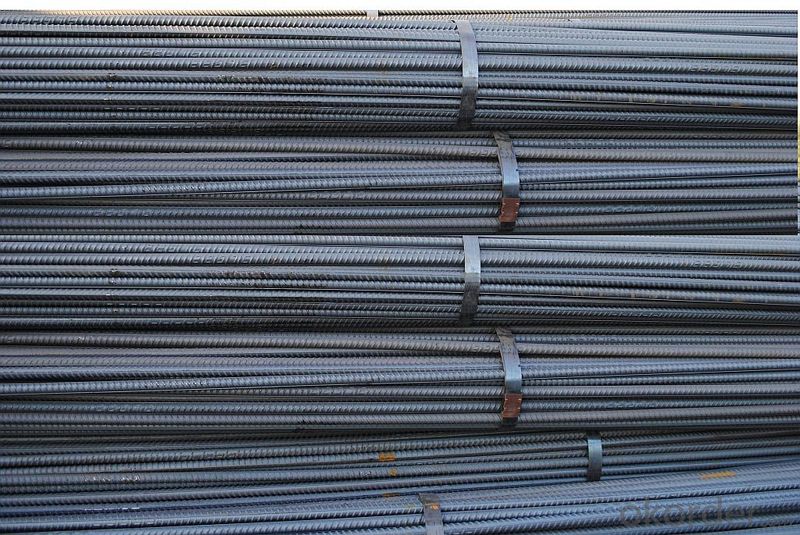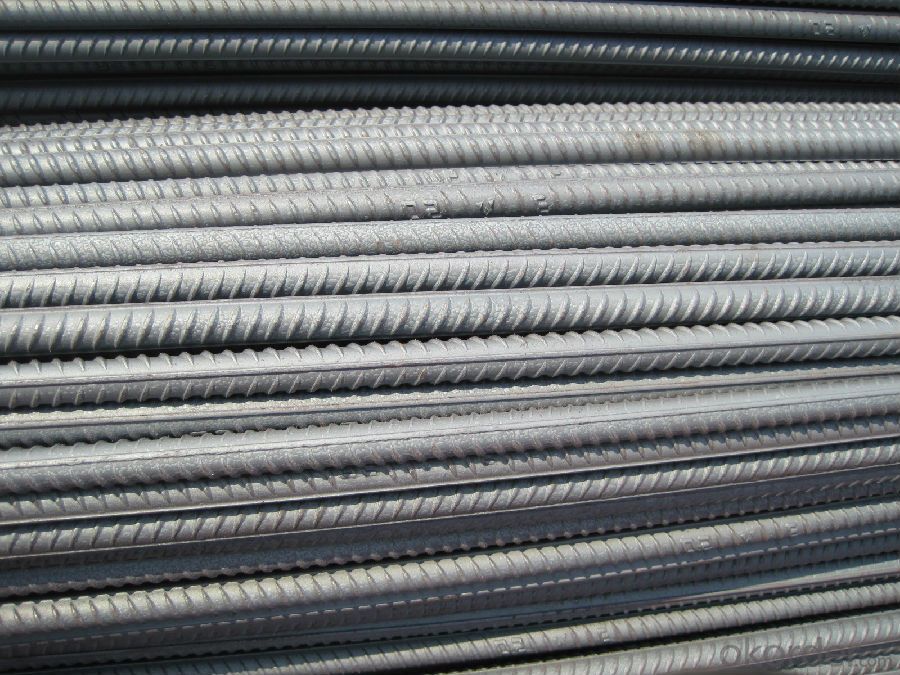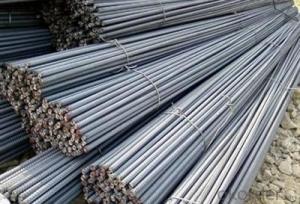Stainless deformed steel bar for construction
- Loading Port:
- Tianjin
- Payment Terms:
- TT OR LC
- Min Order Qty:
- 100000 m.t.
- Supply Capability:
- 10000 m.t./month
OKorder Service Pledge
OKorder Financial Service
You Might Also Like
Item specifice
OKorder is offering stainless deformed steel bar deformed steel bar at great prices with worldwide shipping. Our supplier is a world-class manufacturer of steel, with our products utilized the world over. OKorder annually supplies products to European, North American and Asian markets. We provide quotations within 24 hours of receiving an inquiry and guarantee competitive prices.
Product Applications:
G460B deformed steel bar deformed steel bar are ideal for structural applications and are widely used in the construction of buildings and bridges, and the manufacturing, petrochemical, and transportation industries.
Product Advantages:
OKorder's deformed steel bar are durable, strong, and resist corrosion.
Main Product Features:
· Premium quality
· Prompt delivery & seaworthy packing (30 days after receiving deposit)
· Corrosion resistance
· Can be recycled and reused
· Mill test certification
· Professional Service
· Competitive pricing
Product Specifications:
Manufacture: Hot rolled
Grade: HRB335
Size: 6mm-25mm
Certificates: ISO, SGS, BV, CIQ
Length: 6m – 12m, as per customer request
Packaging: Export packing, nude packing, bundled
Grade | Technical data of the original chemical composition (%) | |||||||
C | Mn | Si | S | P | B | |||
HRB335 | ≤0.25 | ≤1.60 | ≤0.80 | ≤0.045 | ≤0.045 | >0.0008 | ||
Physics capability | ||||||||
Yield Strength(N/cm2) | Tensile Strength(N/cm2) | Elongation (%) | ||||||
≥335 | ≥490 | ≥16 | ||||||
Usage and Applications of HRB400 Deformed Steel Bar:
Deformed bar is widely used in buildings, bridges, roads and other engineering construction. Big to highways, railways, bridges, culverts, tunnels, public facilities such as flood control, dam, small to housing construction, beam, column, wall and the foundation of the plate, deformed bar is an integral structure material. With the development of world economy and the vigorous development of infrastructure construction, real estate, the demand for deformed bar will be larger and larger..
Packaging & Delivery of HRB400 Deformed Steel Bar:
Packaging Detail: products are packed in bundle and then shipped by container or bulk vessel, deformed bar is usually naked strapping delivery, when storing, please pay attention to moisture proof. The performance of rust will produce adverse effect.
Each bundle weight: 2-3MT, or as required
Payment term: TT or L/C
Delivery Detail: within 45 days after received advanced payment or LC.
Label: to be specified by customer, generally, each bundle has 1-2 labels
Trade terms: FOB, CFR, CIF
FAQ:
Q1: Why buy Materials & Equipment from OKorder.com?
A1: All products offered byOKorder.com are carefully selected from China's most reliable manufacturing enterprises. Through its ISO certifications, OKorder.com adheres to the highest standards and a commitment to supply chain safety and customer satisfaction.
Q2: How do we guarantee the quality of our products?
A2: We have established an advanced quality management system which conducts strict quality tests at every step, from raw materials to the final product. At the same time, we provide extensive follow-up service assurances as required.



- Q:What are the challenges associated with the installation of steel rebars?
- There are several challenges associated with the installation of steel rebars. Firstly, the weight of the rebars can be a significant challenge. Steel rebars are heavy and can require heavy machinery or manual labor to lift and maneuver them into place. This can pose a risk to the safety of workers and may require additional time and resources to ensure proper installation. Secondly, the placement of rebars can be challenging, especially in complex or intricate structures. The rebars need to be accurately positioned according to the design and structural requirements, which can be difficult in areas with limited accessibility or in congested reinforcement zones. This requires skilled labor and careful coordination with other trades involved in the construction process. Another challenge is the corrosion protection of rebars. Steel rebars are susceptible to corrosion when exposed to moisture and chemicals in the environment. Therefore, proper measures need to be taken to ensure adequate corrosion protection, such as using protective coatings or ensuring proper concrete cover, which adds complexity to the installation process. Additionally, the coordination between different construction teams is crucial when installing rebars. The rebars need to be properly integrated with other structural elements, such as columns, beams, and walls. This requires effective communication and collaboration between the design team, steel fabricators, and construction teams to ensure seamless integration and avoid any conflicts or delays. Furthermore, the installation of rebars often involves working at heights or in confined spaces, which presents additional challenges in terms of safety and accessibility. Adequate safety measures, such as scaffolding, harnesses, and proper training for workers, are necessary to mitigate the risks associated with working at these conditions. Lastly, the cost of steel rebars can be a challenge, especially when working with tight budget constraints. Steel rebars are a significant component of the construction process, and their cost can fluctuate due to market conditions or availability. This makes it crucial for project managers to carefully plan and budget for the installation of rebars to avoid unexpected cost overruns. In conclusion, the installation of steel rebars comes with various challenges, including the weight of the rebars, accurate placement, corrosion protection, coordination with other trades, working at heights or in confined spaces, and cost considerations. Addressing these challenges requires skilled labor, proper planning, effective communication, and adherence to safety protocols.
- Q:What are the different types of steel rebars available?
- There are several different types of steel rebars available, each with its own unique properties and applications. Some of the most common types include: 1. Mild Steel Rebars: These are the most commonly used type of rebars and are known for their high strength and durability. They are typically used in general construction projects and can withstand heavy loads. 2. High-Strength Deformed (HSD) Rebars: These rebars are made from carbon steel and are heat-treated to enhance their strength and elasticity. They have enhanced resistance to corrosion and are commonly used in high-rise buildings, bridges, and other structures that require extra strength. 3. European Rebars: These rebars are manufactured according to European standards and are typically made from mild steel. They have a ribbed surface to provide better adherence to concrete and are used in various construction applications. 4. Carbon Steel Rebars: These rebars are made from carbon steel and have a high carbon content. They have excellent strength and are widely used in structures that require exceptional durability, such as bridges and highways. 5. Epoxy-Coated Rebars: These rebars are coated with an epoxy layer to prevent corrosion and enhance their longevity. They are commonly used in marine structures and areas with high humidity or salt exposure. 6. Galvanized Rebars: These rebars are coated with a layer of zinc to provide protection against corrosion. They are commonly used in areas with high moisture content or in coastal regions. 7. Stainless Steel Rebars: These rebars are made from stainless steel and are highly resistant to corrosion. They are used in specialized applications, such as in areas with chemical exposure or in structures that require exceptional durability. It is important to choose the appropriate type of steel rebar based on the specific requirements of the construction project, including load-bearing capacity, corrosion resistance, and environmental conditions. Consulting with a structural engineer or construction professional can help determine the best type of rebar to use for a particular project.
- Q:How do steel rebars affect the overall structural stability of a building?
- The overall structural stability of a building is greatly improved with the use of steel rebars. These reinforcing bars are commonly employed in concrete structures to provide additional strength and support to the building's framework. By embedding steel rebars within the concrete, the building's overall structural integrity and load-bearing capacity are significantly heightened. The main purpose of steel rebars is to reinforce and strengthen concrete, which is susceptible to tension forces. Concrete possesses excellent compressive strength but has limited resistance to tensile forces. Steel rebars, which are highly tensile in nature, counteract these tension forces and prevent the concrete from cracking or failing when under stress. Rebars are strategically placed within the concrete to more efficiently distribute and transfer loads. This redistribution of forces reduces the likelihood of localized structural failures and ensures that the building can withstand external forces such as wind, seismic activity, or heavy loads. Furthermore, steel rebars also improve the durability and longevity of a building. By reinforcing the concrete, rebars help minimize cracking and prevent the propagation of cracks. This is particularly important in areas prone to seismic activity since rebars can absorb and dissipate energy generated during an earthquake, reducing the risk of collapse. In addition to their role in ensuring structural stability, steel rebars also offer design flexibility. They can be shaped and bent into various configurations, enabling architects and engineers to create complex and innovative structures effortlessly. This design flexibility not only enhances the aesthetics of the building but also allows for the construction of unique architectural features that would otherwise be difficult or impossible to achieve. In summary, steel rebars are vital for enhancing the overall structural stability of a building. By reinforcing the concrete, they increase its load-bearing capacity, improve resistance to tensile forces, and more efficiently distribute loads. Their presence significantly reduces the risk of structural failure, enhances durability, and allows for greater design flexibility.
- Q:What is the impact resistance of steel rebars?
- The impact resistance of steel rebars is generally high due to the material's ability to absorb and distribute forces upon impact, making it a reliable choice for reinforcing structures and withstanding sudden loads or accidental impacts.
- Q:How do steel rebars affect the shrinkage and creep behavior of concrete?
- Steel rebars can significantly affect the shrinkage and creep behavior of concrete by providing reinforcement and reducing the overall cracking potential. The presence of rebars helps to distribute the tensile stress induced during drying shrinkage, thereby minimizing the development of cracks. Additionally, rebars can restrain the movement of concrete, reducing the creep deformation and improving the long-term stability of the structure.
- Q:What are the safety precautions to be taken while handling steel rebars?
- When handling steel rebars, it is important to follow several safety precautions. First and foremost, proper personal protective equipment (PPE) should be worn, including gloves, safety glasses, and steel-toed boots. This will help protect against potential injuries and hazards. Additionally, it is crucial to lift and carry rebars using proper lifting techniques and equipment, such as using cranes or forklifts, as rebars can be heavy and awkward to handle. Workers should also be cautious of sharp edges or protruding ends of rebars and ensure they are properly capped or covered. Lastly, it is essential to maintain a clean and organized work area, removing any obstacles or tripping hazards to prevent accidents.
- Q:Can steel rebars be used in structures with high chloride exposure?
- No, steel rebars should not be used in structures with high chloride exposure as they are susceptible to corrosion in such environments.
- Q:What is the purpose of steel rebars in construction?
- The purpose of steel rebars in construction is to provide reinforcement and strength to concrete structures, preventing cracking and ensuring stability.
- Q:Can steel rebars be used in tunnel boring machine (TBM) construction?
- Yes, steel rebars can be used in tunnel boring machine (TBM) construction. Rebars are commonly used in the construction industry to reinforce concrete structures, including tunnels constructed using TBMs. The purpose of using rebars is to provide additional strength and durability to the concrete lining of the tunnel. These rebars are typically placed within the concrete lining during the construction process to enhance its structural integrity and ability to withstand external forces. In TBM construction, the rebars are carefully positioned and secured to ensure proper reinforcement throughout the tunnel. Therefore, steel rebars play a crucial role in the construction of tunnels using TBMs.
- Q:What are the guidelines for protecting steel rebars in structures exposed to aggressive chemicals?
- To ensure the longevity and structural integrity of steel rebars in structures exposed to aggressive chemicals, several guidelines must be followed. These guidelines include the careful selection of materials, maintaining an adequate concrete cover, using high-quality concrete, conducting regular inspection and maintenance, applying surface protection, implementing a proper drainage system, considering chemical-resistant design, and complying with industry standards and codes. When it comes to material selection, it is crucial to opt for corrosion-resistant options like stainless steel or epoxy-coated rebars. These materials offer enhanced protection against chemical attack and corrosion. Additionally, maintaining a sufficient thickness of concrete cover is essential to prevent direct contact between the rebars and aggressive chemicals. Strict adherence to the minimum concrete cover requirements specified by design codes or project specifications is necessary. Furthermore, the concrete used in structures exposed to aggressive chemicals should have a high resistance to chemical attack. This can be achieved by using a concrete mix design that incorporates suitable chemical-resistant admixtures and aggregates. Regular inspection of the structure is also important to identify any signs of deterioration or damage to the rebars. Any cracks, spalling, or exposed rebars should be promptly repaired and protected to prevent further corrosion. Applying a protective coating or membrane to the surface of the concrete can provide an additional layer of defense against aggressive chemicals. These coatings act as a barrier, preventing direct contact between the rebars and chemicals. Proper drainage in the structure is crucial to minimize the accumulation of aggressive chemicals, and incorporating weep holes, drainage pipes, or waterproofing membranes can help facilitate efficient drainage. Considering the potential chemical exposure in the design of the structure is essential. This involves selecting appropriate materials, arranging rebars carefully, and incorporating protective measures such as chemical-resistant coatings or linings. Compliance with industry standards and codes, such as those issued by the American Concrete Institute (ACI) or the International Concrete Repair Institute (ICRI), is necessary to ensure proper protection of the rebars. By following these guidelines, engineers and construction professionals can effectively safeguard steel rebars in structures exposed to aggressive chemicals. This minimizes the risk of corrosion and maintains the structural integrity of the construction.
1. Manufacturer Overview |
|
|---|---|
| Location | |
| Year Established | |
| Annual Output Value | |
| Main Markets | |
| Company Certifications | |
2. Manufacturer Certificates |
|
|---|---|
| a) Certification Name | |
| Range | |
| Reference | |
| Validity Period | |
3. Manufacturer Capability |
|
|---|---|
| a)Trade Capacity | |
| Nearest Port | |
| Export Percentage | |
| No.of Employees in Trade Department | |
| Language Spoken: | |
| b)Factory Information | |
| Factory Size: | |
| No. of Production Lines | |
| Contract Manufacturing | |
| Product Price Range | |
Send your message to us
Stainless deformed steel bar for construction
- Loading Port:
- Tianjin
- Payment Terms:
- TT OR LC
- Min Order Qty:
- 100000 m.t.
- Supply Capability:
- 10000 m.t./month
OKorder Service Pledge
OKorder Financial Service
Similar products
New products
Hot products
Related keywords





























